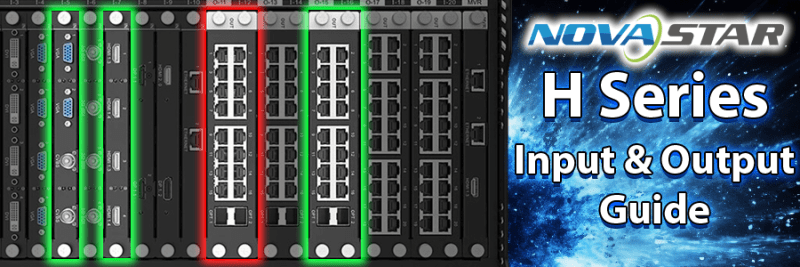NovaStar H-Series Input and Output Card Guide
Hampus Niskala |1/06, 2024

Selecting the appropriate input and output cards for your NovaStar H-Series Video Splicing Processor is crucial for optimizing performance and ensuring seamless operation. The H-Series, including models like the H5, H9, and H15, offers a modular and flexible design that allows for a variety of configurations to meet diverse application needs. In this article, we'll guide you through the process of choosing the right input and output cards for your specific requirements.
Understanding Your Needs
Before diving into the specifics of input and output cards, it's essential to understand your project's requirements. Consider the following factors:
- Type of Input Sources: What types of video sources will you be using (e.g., HDMI, DVI, SDI, VGA, DP)?
- Output Requirements: What kind of displays are you driving (e.g., LED screens, projectors, monitors)?
- Resolution and Pixel Capacity: What is the resolution and pixel capacity of your display setup?
- Application Environment: Are you setting up for a fixed installation, a rental event, or a broadcast environment?
Input Cards
NovaStar's H-Series supports a wide range of input cards to accommodate various video sources. Here are some of the most commonly used input cards:
H_4×HDMI Input Card:
- Description: Supports four HDMI inputs.
- Use Case: Ideal for setups requiring multiple HDMI sources, such as media players, cameras, and computers.
H_4×DVI Input Card:
- Description: Supports four DVI inputs.
- Use Case: Suitable for professional video sources and high-resolution graphics.
H_1×HDMI2.0+1×DP1.2 Input Card:
- Description: Supports one HDMI 2.0 input and one DisplayPort 1.2 input.
- Use Case: Perfect for high-definition video sources and modern display interfaces.
H_4×3G SDI Input Card:
- Description: Supports four 3G SDI inputs.
- Use Case: Ideal for broadcast environments and professional video production.
H_2×RJ45 IP Input Card:
- Description: Supports two RJ45 IP inputs.
- Use Case: Suitable for IP camera sources and networked video inputs.
H_2×CVBS+2×VGA Input Card:
- Description: Supports two CVBS and two VGA inputs.
- Use Case: Great for legacy video sources and computer graphics.
Output Cards
Output cards are equally important as they determine how the processed video is delivered to your displays. Here are some of the key output cards available for the H-Series:
H_4×HDMI Output Card:
- Description: Supports four HDMI outputs.
- Use Case: Ideal for driving multiple HDMI displays or projectors.
H_4×DVI Output Card:
- Description: Supports four DVI outputs.
- Use Case: Suitable for professional monitors and high-resolution displays.
H_4×OPT Output Card:
- Description: Supports four optical outputs.
- Use Case: Perfect for long-distance signal transmission and large-scale installations.
H_16×RJ45+2×Fiber Sending Card:
- Description: Supports 16 RJ45 and 2 fiber outputs.
- Use Case: Ideal for large LED screen setups requiring high pixel capacity and redundancy.
H_20×RJ45 Sending Card:
- Description: Supports 20 RJ45 outputs.
- Use Case: Suitable for extensive LED display configurations with high pixel demands.
Making the Right Choice
To choose the right input and output cards for your NovaStar H-Series Video Splicing Processor, follow these steps:
Assess Your Input Sources:
- Identify the types and number of video sources you will be using.
- Select input cards that match these sources (e.g., HDMI, DVI, SDI).
Determine Your Output Needs:
- Consider the type and number of displays you need to drive.
- Choose output cards that provide the necessary connections and pixel capacity.
Plan for Scalability:
- If you anticipate future expansion, select cards that offer flexibility and scalability.
- Consider cards with higher pixel capacities and multiple output options.
Consult the Specifications:
- Review the specifications of each card to ensure compatibility with your H-Series processor model.
- Check for any additional features that may benefit your setup, such as redundancy or long-distance transmission.
Conclusion
Choosing the right input and output cards for your NovaStar H-Series Video Splicing Processor is essential for achieving optimal performance and meeting your specific project requirements. By understanding your needs and carefully selecting the appropriate cards, you can ensure a seamless and efficient setup.
For more information or to purchase input and output cards for your H-Series processor, visit our H-Series IO Card category page or contact our support team at [email protected]. We're here to help you find the perfect solution for your LED display projects.

 Svenska
Svenska
 Polskie
Polskie
 Español
Español
 Italiano
Italiano
 Deutsch
Deutsch
 Suomi
Suomi
 Français
Français
 Nederlands
Nederlands